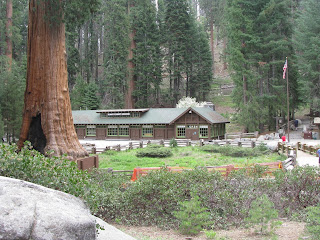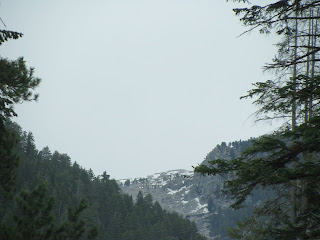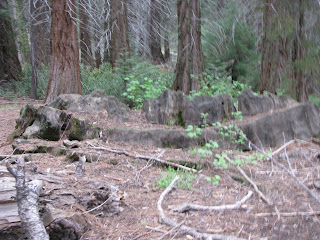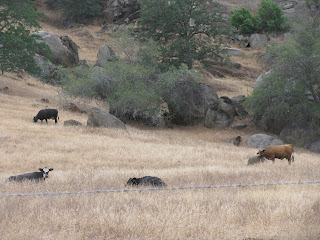
We timed our drive back up the mountain on Thursday perfectly to make the 10 am road opening. The same nice flag man remained in charge. While waiting, we noticed the two vans in front of us had licenses from Ontario, while the two cars behind us held German speaking occupants. The road opening times allow for movement up the mountain and down the mountain by visitors with time in between for the big dump trucks to come and go.

As we looked up, snow capped peaks towered over us. We look beyond the flagman's location and see the roadway we would soon travel high above the valley
The work crews are resurfacing the highway. That's quite an accomplishment on this highway road that climbs to over 7000 feet elevation.
Once the flagman signaled us to go, the long line of cars begin to move up the mountain again.
As the road winds upward, I could look down and back to see the traffic move up the mountain.
We passed the entrance road to Crystal Cave. The cave possesses formations of ornate marble polished by an underground stream. The walk from the parking lot to the cave entrance requires a steep 1/2 mile hike. The tour itself runs about 50 minutes. We chose not to do the cave this time. A sign notifies visitors that cave admittance by ticket only. The tickets may be purchased at the visitor centers either....one hour back down the hill or one hour up the hill. We chuckled at the thought of visitors not knowing this and driving that hour only to discover they need a ticket. We like caves and may return to see it at a later time.

The striking color of the giant sequoia trunks as well as their massive size help it stand out among other trees of the forest.
The large stand of sequoia impressed us as the road turned toward the Giant Forest Museum. Compare the size of the VW camping van with the base of a sequoia.
Our first stop, the Giant Forest Museum, offered a wealth of information. The first reader board (above) told of the first visitors to the park. They arrived and built a big lodge, cabins, a restaurant and a gift shop right next to the giant trees. The trees began to fall over on the cabins. Those pioneers didn't realize the giant tree roots only go down about 3 feet. The building foundations and plumbing pipes damaged the tree roots causing them to fall. Today those buildings have been removed and smaller tree friendly structures have been placed here.
The mighty sequoia is not the tallest tree, but it is the largest tree. You couldn't climb a sequoia even if you wanted to do it. The massive trunks remain thick far up the tree. It differs from most conifers in that the trunks don't taper near the top. These columnar trunks provide for most of the bulk that makes this tree famous.
The Sentinel stands outside of the museum, and far enough away to protect its root system. At 700 tons the weight of two fully loaded jumbo jets, the Sentinel is still just an average sequoia. Others around here are twice as big. The Sentinel age estimate is 2200 years.
Sequoias don't grow just anywhere not even in the sequoia belt. The conditions must be soil that is moist, but not soggy. Elevations above 7500 feet are too cold, and those below 5000 feet are too dry. In all the world, sequoias only grow on the western slope of the Sierras. The sequoia is often confused with the redwoods that grow taller and thinner mainly on the coast of northern and central California. Four of the five largest trees in the world grow here. General Sherman, the Washington, the President, and the Lincoln Trees. The fifth biggest tree General Grant grows down the road in the King's Canyon park. The sequoias grow naturally in only 75 groves. All of which stand within 200 miles of here. The largest grove is the Giant Forest which covers three square miles.
Most Sequoias die from falling because of root damage, wind or heavy snow. Humans are also responsible for sequoia loss. Witnesses describe hearing a loud snap of the roots followed by a roar similar to the combination of a freight train and avalanche as the giant falls. Sequoias live a natural life of more than 3000 years. Long life and rapid growth contribute to their immense size.
Their adaptive qualities also help them survive over the years. In times of fire, competing trees burn away opening up the forest and giving the sequoias more light, moisture and nutrients. It also kills fungus that can damage their roots. The sequoia's thick bark protects the living layers beneath it. Tannin in the bark is resistant to fire and damaging insects. The sapwood is watery and doesn't burn well. The heartwood resists rot and fungus also with the help of tannins a reddish chemical. Its root system, though shallow is very extensive in its search for water.
This museum also had a large fire exhibit telling the benefits of fire. Foresters used to try to stop fire, until they learned it is necessary for the continued growth of some trees. The sequoia needs the heat to release its seeds, which fall into the ashes and then grow. In Yellowstone NP the lodge pole pine uses fire the same way. For the sequoia, fire creates conditions for the seeds to germinate. Heat rising from the fire dries overhanging cones causing them to open and rain seeds onto the fire-cleared, ash-fertilized ground. Millions of seedlings sprout after a fire.

This is a good example of how the sequoia heals itself over a wound.
This acrylic display compared the sequoia with other known items. Unfortunately I didn't take note of what they all were. From the left...1st dot unknown,
2nd dot...the space shuttle,
3rd dot...a blue whale,
4th dot...a sequoia,
5th dot....ocean liner ( Titanic or Queen Mary?)
6th dot...a dinosaur,
7th dot...redwood tree and the
8th dot...Statue of Liberty.
This giant tree starts with a tiny little seed. I thought they were about the size of a shelled sunflower seed or smaller.
Lots of bear warnings throughout the park.
Next we headed to Moro Rock. The road passes several of the big trees. We learned in the museum that 64 miles of trails wind through the sequoias.

Moro rock offers visitors an spectacular view of the park from its granite top. However to get there requires the visitor to walk 1/4 miles up steep stairs that rise 300 feet in elevation. At the top you could stand at 6725 feet of elevation. On another day or time, we may have taken Moro Rock on and hiked to the top...not today. Look carefully at the photos, I caught some people in each one.
Buttress Tree measures a length of 272 feet, base diameter of 20 feet and an estimated age of 2300 years. It fell without warning on June 3, 1959. The weather was clear. Sequoias lose their balance and fall when their shallow roots are damaged by fire, erosion or very wet soil.
The Parker grove of tree were assigned the name of the Parker family. Captain James Parker of the 4th cavalry was acting superintendent of the park 1893-1894.
Our first sign of wildlife showed up along this road to Crescent Meadow. We noted their pale color compared to deer in other areas.
More wildlife....
I also learned that the California Grey Squirrel can be found from the Imperial Valley floor to 8500 feet of the Sierras. They feed on grass seed and herbs. They also may hibernate in the summer when temperatures rise and food is scarce.
Tunnel Log is the only tree you can drive through in these parks. Tunnel Log fell Dec. 4th, 1937. It's base diameter measures 21 feet with a length of 275 feet. The tunnel measures 8 feet high and 17 feet wide. An alternate way around the tunnel is provided for oversize vehicles.
We drove to Crescent Meadow where sequoias tower over a fragile wetland. The mile loop trail to the meadow and back includes a look at Tharp's Log, where he made a cabin from a fallen sequoia, and maybe a look at Mt. Whitney (14,500 feet) the highest mountain in the lower 48 states. From here you can also begin a 60 mile hike on the High Sierra Trail. Again we passed on the walk. Perhaps on a warmer day when I'm feeling stronger.
Slabs of rock show up among the trees of the forest.
I neglected to take a photo of the path near us. We had already descended a ways and I was thinking the walk was pretty easy. Then I looked down and saw where we were going. The walk down isn't bad, coming back up ????
To see General Sherman people without disability passes need to drive past the closest parking lot and around up the mountain. From the parking lot to the tree is a half mile walk down hill. Some easy stairs take you down. Then there is a return hike back up the hill. Benches are found along the way for resting. From a point where you can see General Sherman from a distant a posted sign reminds visitors: "Slow down and enjoy yourself. Air is thin here at 7000 feet. Take your time and enjoy the view as you climb back up to the parking lot." I cheated and waited in the disability parking lot, while Derrille climbed back up and brought the car to me. What a guy!
This slab of a sequoia tree tells its story. The growth rings show it lived about 2,210 years and it survived at least 80 different fires that burned hot enough to leave a scar. This slab came from a tree that threatened a cabin and was cut down in 1950. Recognizing the danger to both people and trees, the park moved overnight facilities out of the grove. Visitors no longer risk having trees fall on them in their sleep, and two thousand year old sequoias no longer risk being felled because they lean over little cabins.
General Sherman rates as the largest tree in the world by volume of its trunk. Some trees are taller, but no other tree has more wood than the General Sherman. Even though the top of the tree is dean, it continues to increase the volume of its trunk every year. Natural growth and fire scars cause the uneven shape. General Sherman facts:
volume =52,500 cubic feet,
weight= 1,385 tons,
width= 36.5 feet diameter,
height= 180 feet and
age= 2200 years,
circumference = 103 feet.
As matter of perspective a 6 foot human looking up at General Sherman is like a mouse looking up at a 6 foot human. General Sherman is bigger than some older trees that grow in less optimal locations.
The age of most trees is taken with a core sample. The size needed for a sequoia would harm it. So scientist measure just the outer rings and apply mathematical formulas based on old stumps whose rings can be counted. They believe these sequoias are between 1800 and 3000 years old. The oldest living tree is a bristlecone pine that has lived over 4700 years. Most other trees lived to be about 300 years old.
Here is another felled sequoia with a people passage in it. Most trees fall uphill. Fires tend to linger on the uphill side of the tree. It tends to fall in the direction of the fire scars.
Walls of rock intersperse with the forest.
As continue our exploration of Sequoia NP, we notice that those snow covered peaks we've seen from the entrance are now about equal with us.
We made a quick stop at the Lodgepole Visitor Center.
Lunch time. A small van tour is one option for seeing the park. Since this is where they stop at Wuksachi Lodge for lunch we did too. Fortunately we got seated just before they closed after lunch to prep for dinner. The food was excellent! The elevation is 7000 feet.
For those of you who stay in lodges, motels, hotels, etc. I'd recommend staying here at Wuksachi to visit the park. You could take daily trips to see the sights without having the hour plus drive up to the Sequoia groves. You would also have good access to King's Canyon. I don't know what the lodge rooms are like, but since the food was good, I'd expect the same for the accommodations.

From here we drive out of Sequoia Nat'l Park and into King's Canyon National Park. We stop to check out the Grant's Grove Visitor Center.
Although the perspective isn't good, I liked this display. Keep in mind that the seeds are smaller than a shelled sunflower seed and the cones are about 2 inches or so.
Twin trees appear quite often in the groves. Sometimes you can even see three growing together.
This nice stand of tree overlooks the General Grant parking lot. We walked a loop to view the General and other trees of interest. Dusk was descending, and we were getting tired.
Compare the size of this lady with the base of a sequoia and then again with more of the tree in the photo
Can't remember the name of this fallen tree. But it has been here for years without rotting. You can actually walk from one path down to another path.
When the giant trees were first discovered no believed they existed. So in 1875 a 16 foot section of a sequoia with a 24 foot diameter was sent to the Philadelphia Centennial Expo of 1876. Only the outer shell was put on exhibit. The parts were reassembled after shipping. Eastern visitors refused to believe it was all from the same tree and called it a hoax.
General Grant rates as the 3rd largest tree in the world by volume 46,608 cubic feet. Other facts:
height= 268 feet,
weight = 1254 tons,
circumference= 107 feet,
diameter = 40 feet (as wide as our motorhome),
age= 1700 years and the
first branch appears at 129 feet up.
Gen. Grant is the widest known sequoia.
If the sight of the giant sequoias hadn't taken our focus, we could have noticed that dogwood trees showing their spring blossoms grew well among the big trees. They seem to like this elevation.
We learned from a film in the visitor center that Grant's Grove is just a secondary addition to King's Canyon. The U-shaped canyon carved by glaciers remains a day use area only with no food or water available. It's an hours drive from the Grant Grove Visitor Center to the Cedar Grove Visitor Center near the end of the canyon. Several attractions can be visited along the way making the trip even longer. Since we were already two hours from home, we will save this for another time.
Rather than return back over the mountain, we decided to take a local road home. The volunteer at the visitor center said it was full of twists and turns, and about 1 1/2 lanes in spots, but the shortest way back to Three Rivers. The road began as a highway with a number. Then we had to turn onto Dry Creek Road. Some cars sped past us....they must know the road.
These beautiful horses were hanging out in a pasture that bordered a creek.
Being a long way from anywhere makes you wonder how the people earn a living. Then we passed through a section of ranches. Some named their ranches and all posted NO TRESPASSING signs
A variety of cattle grazed as we passed.
About an hour and three quarters later we came up to the back side of Lake Kaweah. Dry Creek Road met up with Hwy 198 and the way back to the RV.
We spent nine hours exploring the Sequoia! What a day. Having done what we came to do, and not liking our accommodations that much, we left early and headed up I-5 to Redding.




























































































